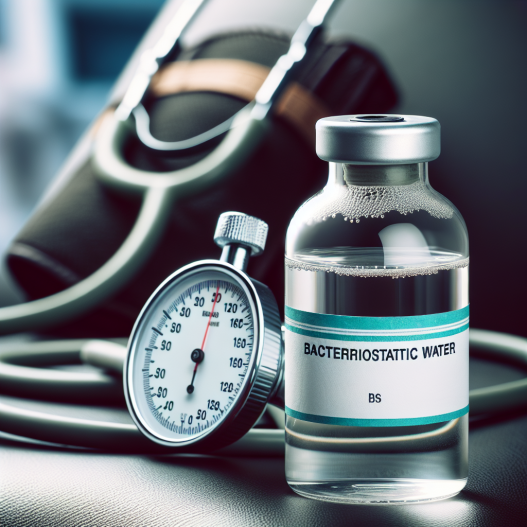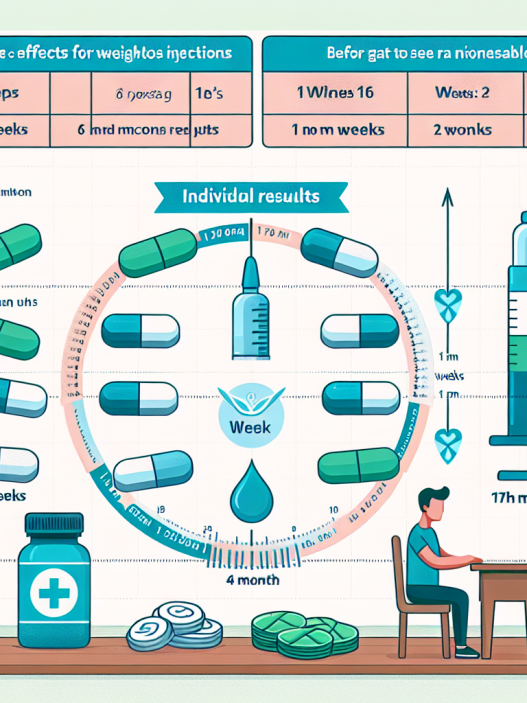-
Table of Contents
- Introduction
- The Importance of Using Agua Bacteriostática for Injection and Blood Pressure: A Comprehensive Guide
- Understanding the Role of Agua Bacteriostática in Maintaining Safe Injections and Healthy Blood Pressure Levels
- Common Mistakes to Avoid When Using Agua Bacteriostática for Injections and Monitoring Blood Pressure
- Q&A
«Keep your injections and blood pressure safe with Agua bacteriostática – the trusted choice for optimal health.»
Introduction
Agua bacteriostática para inyección y presión arterial es un tipo de solución estéril que se utiliza para diluir medicamentos y administrarlos por vía intravenosa. Además de su función como diluyente, esta agua también tiene propiedades bacteriostáticas, lo que significa que puede inhibir el crecimiento de bacterias en la solución y prevenir infecciones. Sin embargo, al utilizar esta agua para inyección y controlar la presión arterial, es importante tener en cuenta ciertos aspectos para garantizar su seguridad y eficacia. En este artículo, discutiremos qué observar al utilizar agua bacteriostática para inyección y presión arterial.
The Importance of Using Agua Bacteriostática for Injection and Blood Pressure: A Comprehensive Guide
Agua bacteriostática, also known as bacteriostatic water, is a sterile solution that is commonly used for injections and diluting medications. It contains a small amount of benzyl alcohol, which acts as a preservative and prevents the growth of bacteria in the solution. This makes it a crucial component in the medical field, especially when it comes to administering injections and monitoring blood pressure.
One of the main reasons why agua bacteriostática is used for injections is because it helps to maintain the sterility of the solution. When administering injections, it is essential to use a sterile solution to prevent the risk of infection. The presence of bacteria in the solution can lead to serious health complications for the patient, which is why using bacteriostatic water is crucial. The benzyl alcohol in the solution helps to inhibit the growth of bacteria, ensuring that the solution remains sterile.
Moreover, agua bacteriostática is also used for diluting medications that are administered through injections. Some medications are too concentrated to be injected directly into the body, and they need to be diluted with a sterile solution. Bacteriostatic water is the preferred choice for dilution as it not only maintains the sterility of the medication but also helps to prolong its shelf life. This is particularly important for medications that are used frequently, as it reduces the risk of contamination and ensures the effectiveness of the medication.
In addition to its use in injections, agua bacteriostática also plays a crucial role in monitoring blood pressure. Blood pressure is a vital sign that helps to assess the overall health of an individual. It is measured by using a sphygmomanometer, which consists of a cuff, a pressure gauge, and a stethoscope. The cuff is inflated with air, and the pressure is released slowly while listening to the pulse with the stethoscope. The reading on the pressure gauge indicates the systolic and diastolic blood pressure.
When measuring blood pressure, it is essential to use a sterile solution to inflate the cuff. This is where bacteriostatic water comes into play. Using a sterile solution ensures that the cuff remains clean and free from any bacteria that could affect the accuracy of the reading. It also helps to prevent any potential infections that could arise from using a contaminated cuff. Therefore, using bacteriostatic water is crucial in maintaining the accuracy and safety of blood pressure measurements.
However, when using agua bacteriostática for injections and blood pressure monitoring, there are certain things that need to be observed. Firstly, it is essential to check the expiration date of the solution before use. Using an expired solution can lead to contamination and compromise the effectiveness of the medication or the accuracy of the blood pressure reading. It is also crucial to ensure that the solution is stored properly, away from direct sunlight and at room temperature.
Furthermore, it is essential to follow the recommended dosage when using bacteriostatic water for dilution. Using too much or too little of the solution can affect the concentration of the medication, leading to potential health risks for the patient. It is also important to use a new vial of bacteriostatic water for each medication or injection to prevent cross-contamination.
In conclusion, agua bacteriostática plays a crucial role in the medical field, particularly in injections and blood pressure monitoring. Its ability to maintain sterility and inhibit the growth of bacteria makes it an essential component in ensuring the safety and effectiveness of these procedures. However, it is important to observe certain precautions when using bacteriostatic water to ensure its effectiveness and prevent any potential risks. By following these guidelines, healthcare professionals can ensure the best possible outcomes for their patients.
Understanding the Role of Agua Bacteriostática in Maintaining Safe Injections and Healthy Blood Pressure Levels
Agua bacteriostática, also known as bacteriostatic water, is a type of sterile water that is commonly used in medical settings for injections. It contains a small amount of benzyl alcohol, which acts as a preservative to prevent the growth of bacteria. This makes it a crucial component in maintaining safe injections and healthy blood pressure levels.
When it comes to administering injections, the safety and well-being of the patient should always be the top priority. This is where agua bacteriostática plays a crucial role. By using this type of water, healthcare professionals can ensure that the injection is free from harmful bacteria that can cause infections and other complications.
One of the main reasons why agua bacteriostática is used in injections is because it is sterile. This means that it is free from any microorganisms that can cause harm to the body. Sterility is essential in medical procedures, especially when it involves injecting substances into the body. Any contamination can lead to serious health risks for the patient.
Moreover, the presence of benzyl alcohol in agua bacteriostática also helps in maintaining the sterility of the injection. This preservative has antimicrobial properties that prevent the growth of bacteria, fungi, and other harmful microorganisms. It also has a mild anesthetic effect, which can help reduce the pain and discomfort during the injection.
Aside from its role in maintaining safe injections, agua bacteriostática also has an impact on blood pressure levels. Blood pressure is the force of blood against the walls of the arteries as it circulates through the body. It is an essential aspect of overall health, and any imbalance can lead to serious health problems.
One of the factors that can affect blood pressure is the presence of bacteria in the body. When bacteria enter the bloodstream, it can cause inflammation and damage to the blood vessels, leading to an increase in blood pressure. This is where the use of agua bacteriostática becomes crucial.
By using sterile water for injections, the risk of introducing bacteria into the body is significantly reduced. This, in turn, can help maintain healthy blood pressure levels. Additionally, the presence of benzyl alcohol in agua bacteriostática can also have a positive effect on blood pressure. Studies have shown that this preservative has vasodilatory properties, which means it can widen the blood vessels and improve blood flow. This can help lower blood pressure and reduce the risk of cardiovascular diseases.
However, it is essential to note that while agua bacteriostática can play a role in maintaining healthy blood pressure levels, it is not a substitute for proper medical treatment. If you have high blood pressure, it is crucial to consult a healthcare professional for proper diagnosis and treatment.
When it comes to using agua bacteriostática for injections, there are a few things that healthcare professionals need to observe. First and foremost, it is essential to ensure that the water is sterile and free from any visible particles. Any discoloration or cloudiness may indicate contamination and should not be used for injections.
Additionally, the concentration of benzyl alcohol in the water should also be checked. The recommended concentration for injections is 0.9%, and anything higher can be harmful to the body. It is also crucial to follow proper storage and handling procedures to maintain the sterility of the water.
In conclusion, agua bacteriostática plays a vital role in maintaining safe injections and healthy blood pressure levels. Its sterility and antimicrobial properties make it a crucial component in medical procedures. However, it is essential to use it properly and follow the recommended guidelines to ensure its effectiveness and safety. As always, consulting a healthcare professional is necessary for any medical concerns.
Common Mistakes to Avoid When Using Agua Bacteriostática for Injections and Monitoring Blood Pressure
Agua bacteriostática, also known as bacteriostatic water, is a sterile solution commonly used for diluting medications for injections. It contains a small amount of benzyl alcohol, which acts as a preservative to prevent the growth of bacteria. This makes it a popular choice for healthcare professionals when administering injections to patients. However, there are certain precautions that need to be taken when using agua bacteriostática, especially when it comes to monitoring blood pressure.
One of the most common mistakes made when using agua bacteriostática for injections is not properly diluting the medication. This can lead to adverse reactions and even serious health complications. It is important to carefully read the instructions provided by the manufacturer and follow the recommended dilution ratio. This will ensure that the medication is properly mixed and safe for injection.
Another mistake to avoid is using expired agua bacteriostática. Just like any other medication, bacteriostatic water has an expiration date. Using expired solution can lead to contamination and potentially harmful effects on the patient. It is crucial to check the expiration date before using the solution and discard any expired bottles.
When it comes to monitoring blood pressure, there are a few things to keep in mind when using agua bacteriostática. First and foremost, it is important to use a sterile needle and syringe when drawing the solution from the vial. This will prevent any contamination and ensure the accuracy of the blood pressure reading.
Additionally, it is important to use the correct amount of agua bacteriostática when diluting the medication. Using too much or too little can affect the accuracy of the blood pressure reading. It is recommended to use the same amount of solution for each injection to maintain consistency.
Another common mistake is not properly labeling the vial of diluted medication. This can lead to confusion and potentially administering the wrong medication to the patient. It is important to clearly label the vial with the name of the medication, the date it was diluted, and the expiration date. This will help avoid any mix-ups and ensure the safety of the patient.
In addition to these precautions, it is important to monitor the patient’s blood pressure before and after the injection. This will help determine if the medication is having the desired effect and if any adjustments need to be made. It is also important to monitor for any adverse reactions or side effects that may occur.
It is crucial to follow proper injection techniques when administering medication using agua bacteriostática. This includes using a clean and sterile injection site, properly disposing of used needles and syringes, and avoiding any air bubbles in the syringe. These steps will help prevent any infections or complications from arising.
Lastly, it is important to properly store and handle agua bacteriostática. The solution should be stored in a cool, dry place and protected from direct sunlight. It should also be kept out of reach of children and pets. If the solution appears cloudy or discolored, it should not be used and should be discarded immediately.
In conclusion, using agua bacteriostática for injections and monitoring blood pressure can be a safe and effective method when done correctly. It is important to follow the recommended dilution ratio, use sterile equipment, and properly label the vial. Monitoring the patient’s blood pressure before and after the injection is also crucial. By avoiding these common mistakes, healthcare professionals can ensure the safety and well-being of their patients.
Q&A
1. ¿Qué es el agua bacteriostática para inyección y presión arterial?
El agua bacteriostática para inyección y presión arterial es una solución estéril que se utiliza para diluir medicamentos y administrarlos por vía intravenosa. También se puede utilizar para mantener la presión arterial en pacientes que necesitan un soporte hemodinámico.
2. ¿Qué observaciones se deben tener en cuenta al utilizar agua bacteriostática para inyección y presión arterial?
Es importante asegurarse de que el agua bacteriostática para inyección y presión arterial esté estéril y no haya sido contaminada. También se debe verificar la fecha de caducidad y seguir las instrucciones de dilución y administración del medicamento que se va a mezclar con el agua bacteriostática.
3. ¿Qué precauciones se deben tomar al utilizar agua bacteriostática para inyección y presión arterial?
Se deben seguir las precauciones estándar de asepsia y esterilización al manipular el agua bacteriostática para inyección y presión arterial. Además, se debe tener cuidado al mezclarla con otros medicamentos y seguir las instrucciones de dilución y administración adecuadas para evitar complicaciones. Siempre se debe consultar con un profesional de la salud antes de utilizar este tipo de solución.















